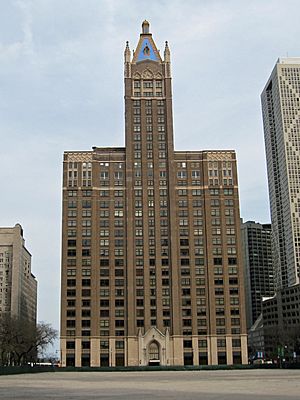Woman's World's Fair facts for kids
The first Woman's World's Fair took place in Chicago in 1925. This special event was completely organized and run by women. Its main goal was to show off the amazing progress women had made in their ideas, work, and products during the 20th century. It was a big step forward for women's achievements.
Contents
About the Fair
The very first Woman's World's Fair happened from April 18 to 25, 1925. It was held in Chicago at the American Furniture Mart Building. The First Lady, Grace Coolidge, officially opened the fair.
This eight-day event was the idea of Helen Bennett and Ruth Hanna McCormick. It was entirely managed by women. The fair featured 280 booths, showing off about 70 different jobs and careers women were involved in. Around 200,000 people visited the fair, and it earned about $50,000.
Why the Fair Was Important
The fair wanted to highlight women's ideas, work, and products in the 1900s. Earlier, at the 1876 Centennial Exposition, there was a Women's Pavilion. It was funded and organized by women, especially Elizabeth Duane Gillespie. The 1893 Chicago World's Fair also showed some women's crafts.
But the 1925 fair was different. It aimed to show how much women had grown in 70 different industries since those earlier fairs. A bonus of the fair was that it helped raise money for women's groups within the Republican Party.
What You Could See
The exhibits at the fair displayed women's achievements in many areas. These included art, writing, science, and business. These displays also aimed to inspire young women thinking about their future jobs.
Many different groups and businesses had exhibits. For example, the Illinois Bell Telephone Company was there. You could also find displays from newspapers, factories, hospitals, banks, and stores. Many local businesses offered job opportunities at the fair.
Women lawyers, inventors, and artists had their own booths. They showed how much women contributed in these fields. For instance, the famous American sculptor Harriet Whitney Frishmuth had her bronze artwork Joy of the Waters on display.
Many women's organizations were also represented. These included the Women's Trade Union League, the Business and Professional Women's Club, and the Visiting Nurse Association. Other groups like the YWCA, Hull House, and the Illinois Club for Catholic Women also participated.
Inspiring Speeches
On April 23, about 1,000 women from Sycamore, Illinois, had breakfast with famous women. An orchestra made up entirely of women played music. Many well-known women gave speeches, including authors, business leaders, and artists. Each speaker had five minutes to share their thoughts.
The main speaker was Nellie Tayloe Ross. She was the only state governor present at the fair. Other speakers included Chicago's collector of internal revenue and the secretary of the Cabinet Department of Commerce for President Herbert Hoover. The medical field was represented by Dr. Alice Hamilton from Harvard University. Judge Kathryn Sellers from Washington, D.C. spoke for the legal profession.
Daily Activities
After the speeches, visitors could explore Whiting Hall. The booths there were decorated beautifully. They showed about a hundred different jobs where women worked. Some unique examples included antique needlework, pottery, silver fox farming, and even goat breeding. Nurses and welfare workers also received special attention. A key message was the importance of being serious, on time, and thorough in any work you do.
A special part of the fair was its daily program. Each day had a different topic. These programs were both educational and fun. Music and dancing were a big part of the daily entertainment. Helen Bennett was the main director of the fair. The Woman's World's Fair was a big success and was held for three more years after this first one.
Images for kids



